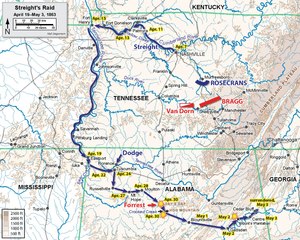| Streight's Raid | |||||||
|---|---|---|---|---|---|---|---|
| Part of American Civil War (1861-1865) | |||||||
 Map of Streight's Raid | |||||||
| |||||||
| Belligerents | |||||||
|
|
| ||||||
| Commanders and leaders | |||||||
|
|
| ||||||
| Strength | |||||||
| 500 | 1,700 | ||||||
| Casualties and losses | |||||||
| 65 | 1,547 | ||||||
Streight's Raid (19 April – 3 May 1863) took place in northern Alabama during the American Civil War (1861-1865). It was led by Union Army Col. Abel D. Streight (1828-1892) and opposed by the Confederate States Army of Brig. Gen. Nathan Bedford Forrest (1820-1877), Streight's goal was to destroy parts of the Western and Atlantic Railroad, which was supplying the Confederate Army of Tennessee to the north. The raid was poorly supplied and planned, and ended with the defeat of Col. Streight and his 1,700 men at Cedar Bluff, Alabama, by Gen. Forrest who bluffed his opponent into surrendering to his 500 men in the town there.[1] Streight was additionally hindered by Southern locals throughout his march, while pursued by Forrest, who had the advantage of knowing the home territory and the sympathy and aid of the local Alabama populace, most famously of Emma Sansom (1847-1900), who later had a statue erected for her in Gadsden, Alabama, which subsequently became controversial in 2020.
- ^ "Streight's Raid", Encyclopedia of Alabama website. Accessed 10 July 2015.